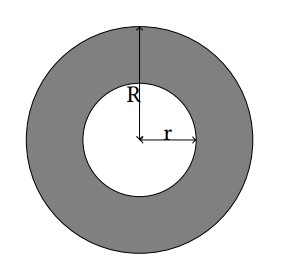Intersection
Time Limit: 4000/4000 MS (Java/Others) Memory Limit: 512000/512000 K (Java/Others)
Total Submission(s): 41 Accepted Submission(s): 22
Problem Description
Matt is a big fan of logo design. Recently he falls in love with logo made up by rings. The following figures are some famous examples you may know.

A ring is a 2-D figure bounded by two circles sharing the common center. The radius for these circles are denoted by r and R (r < R). For more details, refer to the gray part in the illustration below.

Matt just designed a new logo consisting of two rings with the same size in the 2-D plane. For his interests, Matt would like to know the area of the intersection of these two rings.

A ring is a 2-D figure bounded by two circles sharing the common center. The radius for these circles are denoted by r and R (r < R). For more details, refer to the gray part in the illustration below.

Matt just designed a new logo consisting of two rings with the same size in the 2-D plane. For his interests, Matt would like to know the area of the intersection of these two rings.
Input
The first line contains only one integer T (T ≤ 10
5), which indicates the number of test cases. For each test case, the first line contains two integers r, R (0 ≤ r < R ≤ 10).
Each of the following two lines contains two integers x i, y i (0 ≤ x i, y i ≤ 20) indicating the coordinates of the center of each ring.
Each of the following two lines contains two integers x i, y i (0 ≤ x i, y i ≤ 20) indicating the coordinates of the center of each ring.
Output
For each test case, output a single line “Case #x: y”, where x is the case number (starting from 1) and y is the area of intersection rounded to 6 decimal places.
Sample Input
2 2 3 0 0 0 0 2 3 0 0 5 0
Sample Output
Case #1: 15.707963 Case #2: 2.250778
Source
S = A大B大 - A大B小 - A小B大 + A小B小。(A表示A环,大表示大圆,B同)。然后直接套模板。
#include <stdio.h>
#include <algorithm>
#include <string.h>
#include <cmath>
using namespace std;
const double eps = 1e-8;
const double PI = acos(-1.0);
int sgn(double x)
{
if(fabs(x) < eps) return 0;
if(x < 0) return - 1;
else return 1;
}
struct Point
{
double x, y;
Point(){}
Point(double _x, double _y)
{
x = _x; y = _y;
}
Point operator -( const Point &b) const
{
return Point(x - b. x, y - b. y);
}
double operator ^ (const Point &b) const
{
return x*b. y - y*b. x;
}
double operator * (const Point &b) const
{
return x*b. x + y*b. y;
}
void transXY(double B)
{
double tx = x,ty = y;
x = tx* cos(B) - ty*sin(B);
y = tx* sin(B) + ty*cos(B);
}
};
double dist( Point a, Point b)
{
return sqrt((a-b)*(a- b));
}
double Ac(Point c1, double r1, Point c2, double r2)
{
double d = dist(c1,c2);
if(r1 + r2 < d + eps) return 0;
if(d < fabs(r1 - r2) + eps)
{
double r = min(r1,r2);
return PI*r*r;
}
double x = (d*d + r1*r1 - r2*r2)/(2*d);
double t1 = acos(x / r1);
double t2 = acos((d - x)/r2);
return r1*r1*t1 + r2*r2*t2 - d*r1*sin(t1);
}
int main() {
int T; Point c1, c2;
double ans, r, R, x1, y1, x2, y2;
scanf("%d", &T);
for(int cas = 1; cas <= T; ++cas) {
scanf("%lf%lf%lf%lf%lf%lf", &r, &R, &x1, &y1, &x2, &y2);
c1.x = x1; c1.y = y1;
c2.x = x2; c2.y = y2;
ans = Ac(c1, R, c2, R) - Ac(c1, R, c2, r) - Ac(c1, r, c2, R)
+ Ac(c1, r, c2, r);
printf("Case #%d: %.6lf\n", cas, ans);
}
return 0;
} 






 本文介绍了一种计算两个相同大小的环形在二维平面上交集面积的方法。通过定义环形的基本参数,利用数学公式计算不同配置下两环形相交部分的面积,并提供了一个具体的C++实现示例。
本文介绍了一种计算两个相同大小的环形在二维平面上交集面积的方法。通过定义环形的基本参数,利用数学公式计算不同配置下两环形相交部分的面积,并提供了一个具体的C++实现示例。
















 11万+
11万+

 被折叠的 条评论
为什么被折叠?
被折叠的 条评论
为什么被折叠?








